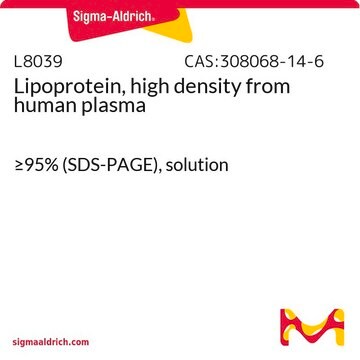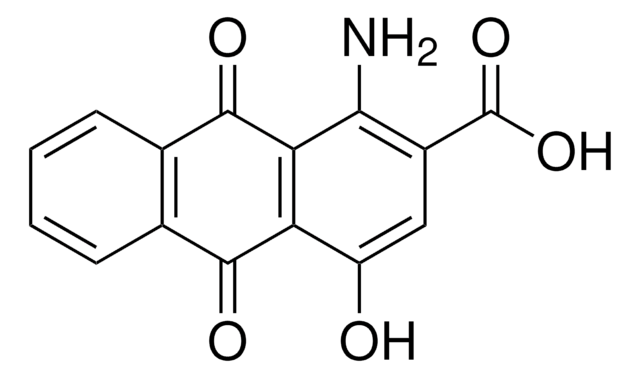SAE0053
Lipoprotein, low density from human plasma, solution
Sinónimos:
LDL, Low density lipoprotein, beta-lipoprotein
Iniciar sesiónpara Ver la Fijación de precios por contrato y de la organización
About This Item
UNSPSC Code:
12352202
NACRES:
NA.61
Productos recomendados
Biochem/physiol Actions
Low-density lipoprotein (LDL) is a lipoprotein that carries cholesterol throughout the body via blood circulation. LDL has a role in dispositioning cholesterol to tissues and organs of the body. Colloquially deemed as the "bad cholesterol", having high levels of LDL can lead to plaque formation in arteries.
LDL and HDL transport both dietary and endogenous cholesterol in the plasma. LDL is the main transporter of cholesterol and cholesteryl esters, and makes up more than half of the total lipoprotein in plasma. LDL is absorbed by the liver and other tissues via receptor mediated endocytosis. The cytoplasmic domain of the LDL receptor facilitates the formation of coated pits; receptor-rich regions of the membrane. The ligand binding domain of the receptor recognizes apo-B100 on LDL, resulting in the formation of a clathrin-coated vesicle. ATP-dependent proton pumps lower the pH inside the vesicle, resulting in dissociation of LDL from its receptor. After loss of the clathrin coat, the vesicles fuse with lysozomes, resulting in peptide and cholesteryl ester enzymatic hydrolysis. The LDL receptor can be recycled to the cell membrane. Insulin, tri-iodothyronine and dexamethasome have shown to be involved with the regulation of LDL receptor mediated uptake
LDL and HDL transport both dietary and endogenous cholesterol in the plasma. LDL is the main transporter of cholesterol and cholesteryl esters, and makes up more than half of the total lipoprotein in plasma. LDL is absorbed by the liver and other tissues via receptor mediated endocytosis. The cytoplasmic domain of the LDL receptor facilitates the formation of coated pits; receptor-rich regions of the membrane. The ligand binding domain of the receptor recognizes apo-B100 on LDL, resulting in the formation of a clathrin-coated vesicle. ATP-dependent proton pumps lower the pH inside the vesicle, resulting in dissociation of LDL from its receptor. After loss of the clathrin coat, the vesicles fuse with lysozomes, resulting in peptide and cholesteryl ester enzymatic hydrolysis. The LDL receptor can be recycled to the cell membrane. Insulin, tri-iodothyronine and dexamethasome have shown to be involved with the regulation of LDL receptor mediated uptake
Disclaimer
RESEARCH USE ONLY. This product is regulated in France when intended to be used for scientific purposes, including for import and export activities (Article L 1211-1 paragraph 2 of the Public Health Code). The purchaser (i.e. enduser) is required to obtain an import authorization from the France Ministry of Research referred in the Article L1245-5-1 II. of Public Health Code. By ordering this product, you are confirming that you have obtained the proper import authorization.
Storage Class
10 - Combustible liquids
wgk_germany
WGK 3
flash_point_f
Not applicable
flash_point_c
Not applicable
Certificados de análisis (COA)
Busque Certificados de análisis (COA) introduciendo el número de lote del producto. Los números de lote se encuentran en la etiqueta del producto después de las palabras «Lot» o «Batch»
¿Ya tiene este producto?
Encuentre la documentación para los productos que ha comprado recientemente en la Biblioteca de documentos.
Nuestro equipo de científicos tiene experiencia en todas las áreas de investigación: Ciencias de la vida, Ciencia de los materiales, Síntesis química, Cromatografía, Analítica y muchas otras.
Póngase en contacto con el Servicio técnico







